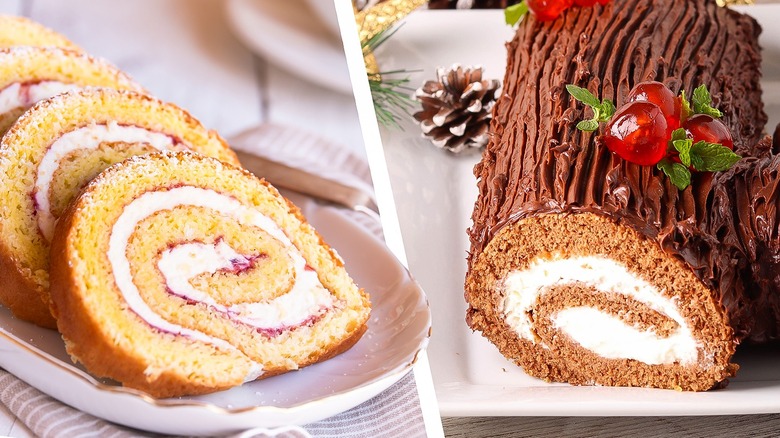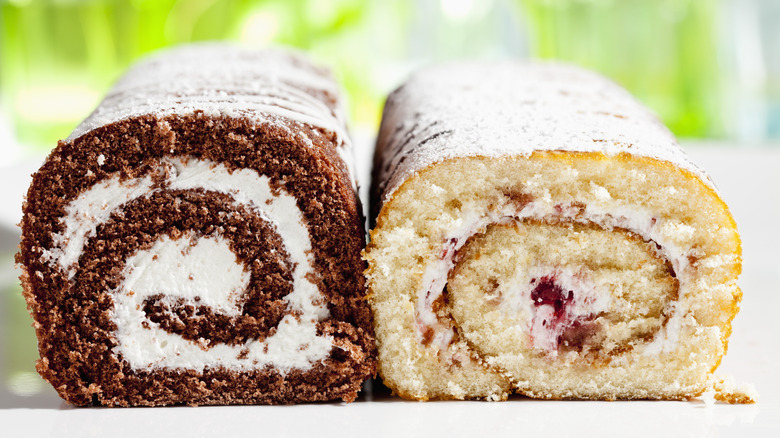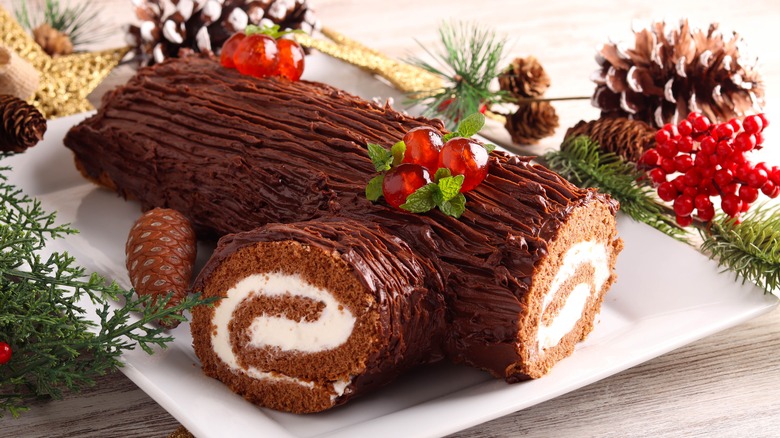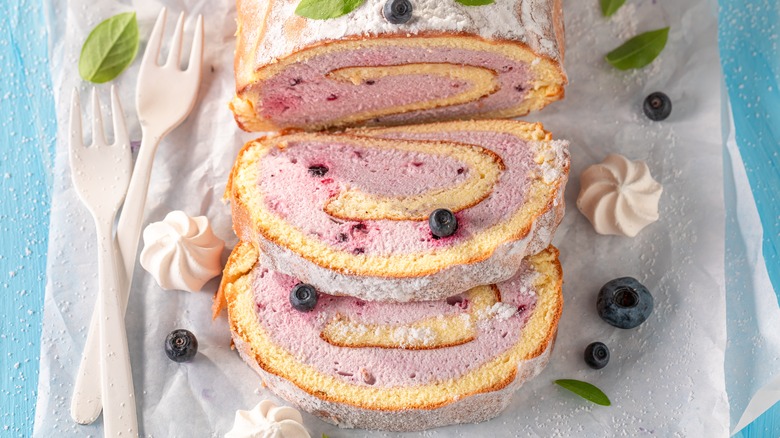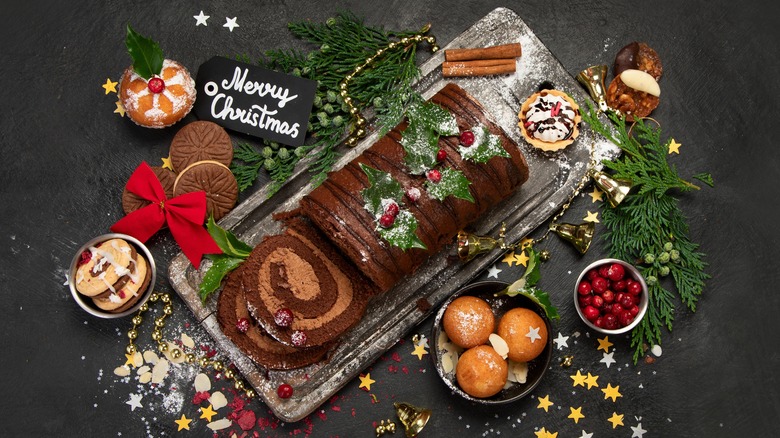Swiss Roll Vs Yule Log Cake: What's The Difference?
We may receive a commission on purchases made from links.
When the holidays roll around, we start seeing cute little gingerbread men, long sheets of peppermint bark, and rolled, cream-filled cakes. But it doesn't have to be Christmas-time to enjoy the latter. Between their layers of thick, fluffy filling and light, spongy cake, roll cakes are delicious treats to sink your fork into any time of year, as long as you know which type to look for.
Swiss rolls and yule log cakes are both examples of rolled up desserts and they both feature a long, round shape. So what exactly is the difference between these two? They have varying backgrounds and, as you may have guessed, are traditionally eaten in different ways. Even just based on their outside appearance, yule log cakes look much more festive than Swiss rolls, largely because of how they're decorated. But each treat also has distinct flavors, and you'd go about preparing them in separate ways. So if you're not sure if you should whip up a Swiss roll or a yule log cake, we'll help you answer that question and more here.
What is a Swiss roll?
Swiss rolls are long, rolled-up cakes, just like their name suggests. They consist of two layers — the cake and the filling — but because of the way they're rolled up, it appears as if there are more. The cake layer is often made with vanilla sponge cake, while the fillings can vary widely. Although these treats are most commonly called Swiss rolls, you may also see them dubbed jelly rolls or cream rolls. You can, of course, make these desserts at home, but they're also sold as packaged items in stores and online, like Little Debbie Swiss rolls.
It's easy to assume that Swiss rolls come from Switzerland, but their history is actually a little murkier. In fact, in Switzerland, dishes that are rolled up (including savory ones) are called "roulade." They may have originated somewhere in Europe in the 1800s, and there are theories that they come from Austria, Slovenia, and Romania. In the U.S., we see the first record of this type of dessert in 1852 New York, from a recipe with cake and jelly. It's likely that the name changed over time, with someone eventually using the term "Swiss roll" by mistake. In 1872, a U.S. cookbook published a recipe under this name, and it seems to have stuck.
What is a yule log cake?
Unlike Swiss rolls, which can be made with a variety of ingredients and in different sizes, yule log cakes are much more specific. The cake portion tends to be made with sponge cake, much like Swiss rolls. But the filling and outside decorations are designed to make the dessert resemble a log (as you can likely guess from its name). These treats also tend to be homemade and look like full-sized cakes.
While the origins of Swiss rolls are shrouded in mystery, it's much easier to trace where yule log cakes come from. They're also known by the name Bûche De Noël, which is the French phrase for "Christmas log," so it's no surprise that they were likely first created in France. The inspiration for these desserts didn't just come from any old Christmas tree — it was derived from the European yule log tradition, which is hundreds of years old and involves burning a specific log every night from Christmas eve until Twelfth Night. While the practice died out sometime in the 1800s, this was around when the log-shaped cake was invented in Paris.
Swiss rolls switch up the filling (and the cake)
You'll find way more variety with Swiss rolls than with yule log cakes. This is largely because the former aren't meant to be eaten during a specific time of the year, so you can really stuff them with anything you want. The classic preparation, deriving from the early U.S. dessert and the name "jelly roll," involves a jelly or jam filling.
The ideal pick here isn't so thin that it will make the cake soggy but also not so bulky that you can't easily smooth it over your base layer. However, you can also use vanilla or chocolate buttercream, whipped cream, or marshmallow fluff. Plenty of bakeries also get creative and infuse fillings with flavors like espresso, pistachio, pumpkin, and caramel. In our Strawberry Lemonade Swiss Roll, we combine a lemon cake with a zingy lemon cream cheese filling that contains chunks of fresh strawberries.
The cake itself doesn't have to be vanilla — or even sponge. Chocolate cakes are a tasty option, along with light and airy chiffon versions. And if you opt for a store-bought package, you'll find everything from orange to hazelnut to red velvet desserts. These treats may be mini versions, full-length cakes, or sliced up treats in boxes.
Yule log cakes channel the Christmas spirit
Since we know that yule log cakes were inspired by a Christmas tradition, it makes sense that these desserts are centered around the holiday. Unlike Swiss rolls, they're meant to look like logs — pretty Christmas-themed logs, that is. There are slightly varying ideas of what this means, but a few things remain consistent among yule log cakes. They almost always have a chocolate cake (reminiscent of bark), although sometimes vanilla cake with a chocolate coating is used to create a multilayered wood effect. However, another way to provide contrast is to deploy a darker chocolate base layer with a white filling or a lighter, chocolate and hazelnut version. While jelly is rarely used to stuff the classic dessert, whipped cream and icing are common.
To further cement their log-like appearance (and add richness), yule log cakes are often covered in a layer of chocolate frosting or ganache once they're rolled up. Then the decorations are open to the baker's creativity. Powdered sugar and whipped cream are often used to depict snow, while sugared cranberries, raspberries, chopped nuts, edible flowers, and rosemary can be used to add to the holiday vibes. It's also common for bakers to drag their forks through the completed cake to create the appearance of grooves in bark. And for the ultra-creative, you can even use your dessert's platter to make a wintery scene with marzipan mushrooms, small pinecones, and mini Christmas figures, like Santa.
